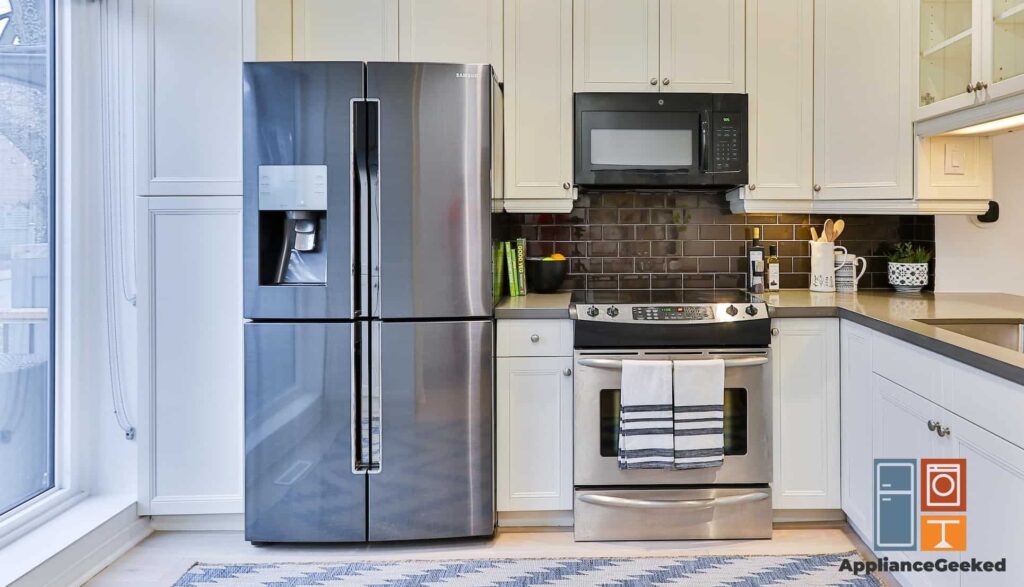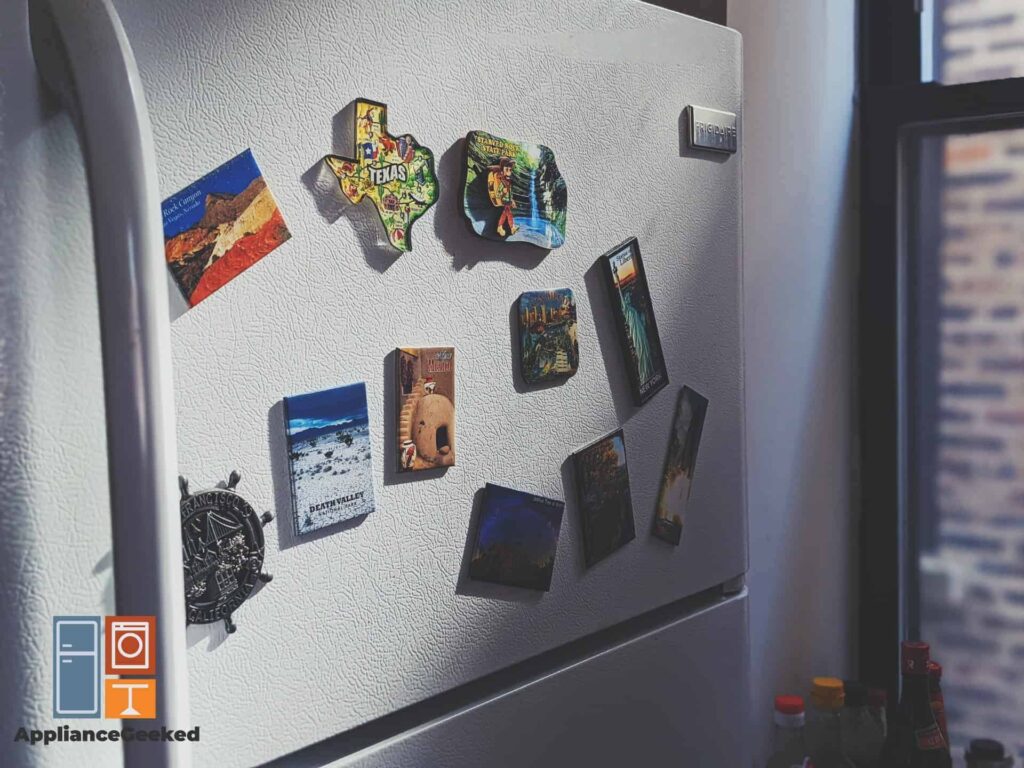Humming, banging, and snapping noises, even when your Samsung fridge doors are closed, are completely normal. No matter how suspicious they seem, they are usually not a cause for concern.
But, how do you know when your fridge is giving you a sign for a repair?
In this guide, we’ll help you learn the difference between normal fridge sounds and unusual ones, which indicate a malfunction. We’ll also give you a few quick fixes, so you can respond to issues immediately and get rid of the loud noises.
Most of these solutions can be performed at home without professional help. Depending on the issue, it might take you one to two days to resolve.
Let’s get right into it.
Why is my Samsung fridge making noise when its door is closed?

A Samsung fridge makes a variety of noises when its doors are closed due to everyday operations. However, loud and repetitive noises are unusual and often caused by cooling issues.
Unusual fridge noises could indicate a malfunction in the doors, ice maker, condenser, or fan.
Take note of what the sounds are like and where they come from. If you can identify its root cause, you can find the best solution and take immediate action, preventing more serious issues from coming up.
Normal Vs. Abnormal Fridge Noise When the Door Is Closed
Humming, snapping, grinding, and hissing are all normal fridge sounds that occur even when the doors are closed. They are mostly a result of a fridge’s normal operations.
On the other hand, hooting, whistling, and beeping are unusual fridge sounds that indicate a need for repair.
| What’s Normal | Cause |
| Humming and Buzzing | A fridge hums and buzzes when the compressor cools the refrigerator. |
| Snapping, Popping, and Crackling | During defrosting, a fridge’s plastic parts expand and contract as the temperature changes, causing snapping, popping, and crackling sounds. New fridges can also produce these noises while they acclimate to their new environments. |
| Grinding | Grinding noises could be produced by the ice maker when it dispenses ice. |
| Hissing, Bubbling, or Gurgling | As the refrigerant moves around the fridge’s system, you will hear hissing, bubbling, or gurgling sounds. |
| Banging | A loud banging sound might be caused by ice falling into the fridge’s bucket. It could also be caused by a heavy item in your fridge that toppled over. |
| What’s Not Normal | Cause |
| Hooting, Blowing, and Whistling | An owl-like noise from your fridge is most likely caused by a cooling issue. It might indicate a problem with the condenser, evaporator fan, or ice maker. Or, it could mean that your fridge lacks adequate ventilation. |
| Beeping | Loud beeping noises when the fridge doors are closed can have different possible causes, including filthy gaskets, improperly attached doors, and cooling issues. |
Which fridge noises are normal?
Refrigerators produce all kinds of noises as part of their normal operations. Low humming, buzzing, snapping, grinding, hissing, and banging are completely normal and shouldn’t be cause for concern.
Here are the most common noises you’ll hear from a Samsung fridge:
Humming and Buzzing
The low humming and buzzing noises of a refrigerator are caused by the compressor when it’s operating.
Located at the back of the fridge, the compressor is responsible for converting the refrigerant gas to a liquid. Whenever the fridge needs cooling, it runs at full speed, producing humming and buzzing sounds.
Snapping, Popping, and Crackling
As the fridge’s temperature rises and falls during the defrosting cycle, its plastic parts tend to expand and contract, which causes snapping, popping, and crackling noises.
New refrigerators also produce these noises when they acclimate to a new environment. They are normal and fade over time.
The volume of the snapping, popping, and crackling noises should be comparable to dropping ice cubes in a warm drink.
Grinding
If your Samsung fridge has an ice maker, you’ll hear grinding noises from your unit whenever ice is dispensed. Whether it’s crushed or cubed ice, your fridge could produce these grinding sounds.
Hissing, Bubbling, or Gurgling
When the fridge’s refrigerant moves around its system, changing from liquid to gas and vice versa, you will hear hissing, bubbling, or gurgling noises.
Banging
A loud banging sound coming from a closed Samsung fridge will most likely be caused by ice falling into the bucket. It will sound like building blocks falling on a wooden table.
Another possible cause of a banging sound is an item falling over. For instance, if you didn’t stack your cans of soda properly, they could topple over and make that sound.
Which fridge noises are unusual?
Hooting, blowing, whistling, and beeping are unusual fridge noises that could indicate a need for repair. They often occur with minor cooling issues caused by a malfunction in the doors, evaporator fan, ice maker, or condenser.
Most of these unusual noises can be resolved without professional help.
Now that you know which fridge sounds are normal, you can easily determine when there are abnormalities.
Here are the unusual noises you might hear from your fridge:
Hooting, Blowing, and Whistling
If you hear owl noises from your refrigerator, such as hooting, blowing, and whistling, they might be caused by a malfunction in the evaporator fan, ice maker, or condenser.
Or, they could be caused by poor airflow.
Your fridge gets overworked without enough ventilation space on its sides, top, and back. Then, it will produce a range of unusual noises.
The good thing is that most of these issues come with a quick fix. You can perform them at home without any professional help.
If the owl noises continue after you’ve done some troubleshooting, they could be caused by a more serious issue with the defrost system. It most likely is a malfunction and will require professional services.
Beeping
A Samsung refrigerator’s loud beeping is often caused by a door alarm. It gets triggered when the doors are left ajar for over three minutes.
If the beeping occurs when the doors are shut, there are three possible reasons: a filthy gasket, an improperly attached door, and a high fridge temperature.
Sometimes, dirt build-up in the gasket prevents the doors from properly closing. After giving the gasket a thorough yet gentle cleanse, the beeping should stop.
If the beeping started after you removed and reattached the fridge doors, you most likely didn’t do it properly. It should stop once the doors are reattached correctly.
The solution requires a lot of steps and great attention to detail. If you feel uncomfortable doing the fix yourself, hire a professional.
Another possible cause for the beeping is the fridge’s temperature. If it gets too high and is no longer safe for food storage, your unit could start beeping loudly.
How to Fix Samsung Fridge Making Noise When the Door Is Closed
To fix a Samsung fridge that is making unusual noises when its door is closed, first, determine the underlying cause of the problem.
Investigate the source of the noise. Check for common issues in the evaporator fan, condenser, ice maker, and doors.
Then, perform a quick fix if possible.
If you’ve ruled out the common problems, and you still hear unusual noises, call the professionals. They can help you diagnose and fix the problem.
Taking immediate action can help you avoid costly repairs in the future. It can also help you extend the life of your appliance.
| Noise | Cause | Solution | Difficulty |
| Hooting, Blowing, or Whistling | Frozen evaporator fan | Unplug the fridge and let it defrost overnight. | Easy |
| Jammed ice maker | Perform a manual defrost, and remove the jammed ice cubes by hand. | Easy | |
| Dirty condenser coils | Unplug the fridge and clean the dirt off the condenser coils using a soft-bristle brush. | Easy | |
| Malfunctioning evaporator fan | Remove the faulty evaporator fan and replace it with a new one. | Difficult | |
| Beeping | Doors aren’t closed properly due to obstructions, or dirt build-up | Check for any obstructions, preventing the door from closing all the way. Make sure there isn’t any build-up of dirt around the door gaskets. Use a vinegar solution or mild soap to clean the gaskets. | Easy |
| Doors weren’t reattached properly | Unplug the fridge. Remove the doors, and reattach them correctly. | Difficult | |
| Fridge temperature is too high | Maintain proper ventilation space and remove any clutter on top of the fridge. Adjust the refrigerator settings using Power Cool or Power Freeze. | Easy-Medium |
Hooting, Blowing, or Whistling
Loud and constant owl-like noises coming from a Samsung fridge doesn’t necessarily indicate a serious problem. They could be a sign of poor ventilation or cleaning.
Solution: Put an end to your fridge’s owl noises by determining the main cause of the problem. Rule out the easiest issues first, starting with ventilation.
- Step 1: Make sure the fridge has adequate ventilation space.
To ensure proper ventilation, there must be at least two inches of space on all sides of the fridge and at least an inch of space at the top and back.
- Step 2: Check the condenser coils.
If the noise persists, check the condenser coils for dirt and grime. Unplug the fridge, and use a soft-bristle brush to remove the dust from the coils.
After, use a damp and soapy towel to remove all the grime from the coils. Wipe them dry before plugging the fridge back in.
- Step 3: Check if the ice maker is jammed.
A fridge’s raker, bucket, or chute can be jammed with ice if your unit is experiencing cooling issues. To fix the problem, do a manual defrost, and remove the clumps of ice by hand.
- Step 4: Check if the evaporator fan is frozen or faulty.
If the refrigerator noise stops when the door is open, the evaporator fan is most likely the culprit. Before assessing the fan for possible issues, unplug the fridge.
Remove all the shelving to access the fan, which is located on the fridge’s back wall. Then, unscrew the plastic panel covering it.
A frozen fan can be fixed by manually defrosting the fridge. If the fan is faulty, it needs a replacement.
We have another guide that delves into the different causes of your fridge’s owl noises. We also offer solutions for each potential problem.
Beeping
There are different possible reasons behind a fridge’s beeping noises. They aren’t usually serious and can be fixed right away.
To identify the beeping’s root cause, look for and rule out possible issues, starting with the most common. Check if the doors are properly closed.
Most Samsung fridges have alarms that notify you if the doors aren’t shut properly. Look for any obstructions preventing the doors from closing. Then, remove them.
If the beeping doesn’t stop, here are other possible issues to watch out for, along with their respective fixes.
Door gaskets are filthy.
Each fridge door comes with a rubber gasket that seals the cold inside. If it has a buildup of dirt, the fridge might not close properly and cause the beeping alarm.
Solution: Follow these steps to fix a dirty door gasket:
- Step 1: Check the door seals for dirt build-up.
- Step 2: Mix half a cup of water and a tablespoon of vinegar in a small bowl.
- Step 3: Dip a soft dishcloth in the vinegar solution.
- Step 4: Clean the gasket using the vinegar solution.
Avoid using harsh detergents to clean the door gaskets. They can do more harm than good.
Doors aren’t attached properly.
If the beeping noises started after the fridge doors were removed and reattached, the doors need to be reattached properly.
Solution: Use the fridge manual as a reference for all the different parts and compartments. Follow these steps to attach the fridge doors properly:
- Step 1: Transfer perishable goods before unplugging the fridge.
- Step 2: Remove the screws and the cover hinge from the top fridge door.
- Step 3: Disconnect the electrical wires.
- Step 4: Use a wrench to remove the bolts attaching the hinge to the fridge’s top section.
- Step 5: Separate the hinge from the electrical wires.
- Step 6: Lift the upper fridge door to detach it.
- Step 7: Remove the screw and bolts from the middle hinge.
- Step 8: Gently lift the freezer door to remove it.
- Step 9: Detach the screw from the cover hinge at the bottom of the fridge.
- Step 10: Attach the hinge and cover hinge on the opposite side.
- Step 11: Remove the screws on the fridge’s left and right sides.
- Step 12: Remove the grommet, stopper mid, and stopper door at the bottom right side of the freezer door.
- Step 13: Attach the grommet, stopper mid, and stopper door on the opposite side.
- Step 14: Remove the door switch, cap door switch, and sleeve.
- Step 15: Attach the door switch, cap door switch, and sleeve on the opposite side.
- Step 16: Attach the lower hinge to the grommet hinge hole, and the middle hinge to the door hole. Insert a washer, too.
- Step 17: Attach the hinge and the door to the unit, including a washer.
- Step 18: Check the door if it closes and opens properly.
- Step 19: Remove the screws, stopper door, and grommet.
- Step 20: Attach the stopper door and grommet on the opposite side.
- Step 21: Attach the freezer door to the fixed hinge in the middle of the unit.
- Step 22: Remove the cover cap door and cover hinge.
- Step 23: Remove the grommet and cap wire, before reattaching them on the opposite side.
- Step 24: Reattach the hinge, bolts, and electrical wires at the top part of the fridge.
- Step 25: Screw the cover hinge into place.
- Step 26: Check if the top fridge door opens and closes properly.
Fridge temperature is too high.
Loud beeping noises, along with a blinking display, indicate a problem with the fridge’s temperature. It is getting too high, reaching a range that is unsafe for food storage.
Solution: To fix your fridge’s cooling problem, here are a few solutions that may help:
- Step 1: Maintain adequate ventilation.
Aside from ensuring proper ventilation space, remove any clutter on top of the fridge, especially heat-generating items.
Refrain from using the space as storage for small appliances like toasters and air fryers because they add extra heat to your unit.
- Step 2: Keep the fridge at least ⅔ full.
A fridge uses a lot of energy to replace the cool air that seeps out whenever you open its doors. By keeping the fridge ⅔ full, about ⅓ or less of that air escapes, which reduces the amount of air it needs to replace.
- Step 3: Let food cool down before storing it in the fridge.
Avoid putting hot food in the fridge because it can raise the temperature of an entire compartment. At the same time, it can cause the food right next to it to spoil faster.
- Step 4: Adjust the temperature.
If the fridge’s temperature is too high, adjust it to a lower setting using the Power Cool or Power Freeze function. It is located on the control panel on the fridge door.
Just press the Power Cool or Power Freeze button for three seconds. Once the indicator light turns on, the freezer runs at full speed for 50 hours.
After, the temperature will reset to the previous setting.
Some Samsung fridges have FlexZone, which is a full-width drawer that comes with adjustable temperature controls. All you have to do is press the temperature button on the control panel until you reach the desired mode.
The different modes include Wine/Party Dishes, Deli/Snack, Cold Drink, and Meat/Fish. After choosing, the fridge will automatically adjust the temperature to fit the food you have in storage.
If you own a FamilyHub, you can monitor and adjust the fridge’s temperature through SmartThings. Open the app on your phone, and go to the Temperature function.
Choose between Fridge or Freezer, then pick the desired temperature for the selected compartment.




